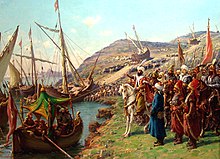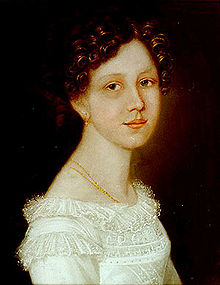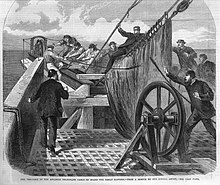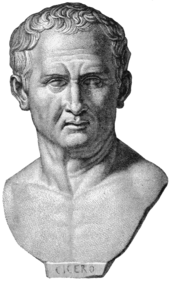Great moments of mankind
Great moments of mankind is a collection of 14 historical miniatures , written by Stefan Zweig , which tell of historical events, the effects of which have changed the history of mankind. The texts are not historical analyzes, but rather pointed narratives, each centered on a biographically exaggerated person. Zweig writes in the foreword:
“Such dramatically concentrated, such fateful hours, in which a timeless decision is concentrated on a single date, a single hour and often just a minute, are rare in the life of an individual and rare in the course of history. [...] I called them that because they shine like stars, shining and unchanging over the night of transience. "
The collection initially appeared with five miniatures as number 165/2 in the Insel-Bücherei in the Leipziger Insel Verlag at the end of 1927 , where it is still present in this form in the publishing program today.
structure
The first edition from 1927, published in the Insel-Bücherei as no. 165/2 with the title addition Five historical miniatures , contained only five texts:
| No. | title | content | year |
|---|---|---|---|
| 1 | The world minute from Waterloo | General Grouchy's unsuccessful attempt to come to the aid of Napoleon ( Battle of Wavre ) | 1815 |
| 2 | The Marienbad Elegy | Goethe's unfulfilled love for Ulrike von Levetzow | 1821 |
| 3 | The discovery of Eldorado | Development of large parts of California by Johann August Sutter (actually Suter) and destruction of his property by the gold rush | 1848 |
| 4th | Heroic moment | Fyodor Dostoyevsky's pardon before his planned execution | 1849 |
| 5 | The battle for the South Pole | Robert Scott's failed South Pole expedition | 1912 |
The following seven texts were added posthumously in 1943:
| No. | title | content | year |
|---|---|---|---|
| 1 | Escape to Immortality | Discovery of the Pacific by Balboa | 1513 |
| 2 | The conquest of Byzantium | Siege of Constantinople and conquest by the Ottomans | 1453 |
| 3 | Georg Friedrich Handel's resurrection | Creation of the oratorio Messiah | 1741 |
| 4th | One night's genius | Rouget de Lisle composes the Marseillaise | 1792 |
| 5 | The first word about the ocean | Laying of the first transatlantic cable on the initiative of the New York merchant Cyrus W. Field | 1858 |
| 6th | The flight to God | Leo Tolstoy's death | 1910 |
| 7th | The sealed train | Lenin's return to Russia | 1917 |
In today's editions you can also find two more texts that were already included in an English edition from 1940
| No. | title | content | year |
|---|---|---|---|
| 1 |
Cicero ( The Head on the Rostrum ) |
Marcus Tullius Cicero's commitment to the restoration of the republic after the assassination of Caesar | 43 BC Chr. |
| 2 |
Wilson failed ( Wilson's failure ) |
Failure of US President Woodrow Wilson in negotiations for the Versailles Peace Treaty | 1919 |
The miniatures are usually structured in the manner of a novella and are not understood as historical analyzes, but as the pointed representation of events in which a historical personality has to prove himself. Zweig does not always remain true to the historical facts, but rather subordinates them in case of doubt to his heroic view of history.
Two texts deviate from the novella form: Heroic Moment is written as a dramatic poem , The Flight to God as an epilogue to And the Light Shines in Darkness , a drama fragment of Tolstoy.
content
The world minute from Waterloo
- Subtitle: Napoleon
- Date: June 18, 1815
structure
- Grouchy
- The night in Caillou
- The morning of Waterloo
- Grouchy's failure
- World history in an instant
- Waterloo afternoon
- The decision
- Fall back into the everyday
Marshal Emmanuel de Grouchy's unsuccessful attempt to come to the aid of Napoléon Bonaparte came on June 18, 1815 when Grouchy stubbornly obeyed his orders instead of boldly riding off to save Napoléon.
He stubbornly obeyed his order to pursue the Prussian Field Marshal Gebhard Leberecht von Blücher and did not rush to Waterloo , where the thunder of cannons could be heard. So he did not come to the aid of the oppressed Napoleon and looked in vain for Blücher, who had long since arrived in Waterloo.
The writer Arnold Bauer writes about this miniature in his Zweig biography:
"A comparatively insignificant episode, such as Grouchy's failure as commander of the French rearguard, is interpreted by the poet as the avalanche of fate that triggered Napoleon's downfall (as if the end of Napoleon had not already been sealed by the European balance of power)."
The Marienbad Elegy
- Subtitle: Goethe between Karlsbad and Weimar
- Date: September 3, 1823
The Marienbader Elegy is a love poem, which deals with Goethe's unfulfilled love for Ulrike von Levetzow .
The story begins with Goethe in the carriage between Karlsbad and Weimar on September 5, 1823. This late love of Goethe in his mid-70s can be described as the apex of his work, which animated him to his older work.
-
The universe is to me, I am lost to
myself, Who was only a favorite of the gods;
They tested me, gave me pandors,
So rich in goods, richer in danger;
You pushed me to the forked mouth,
you separate me and ruin me.- (Excerpt from the Marienbad Elegy)
The discovery of Eldorado
- Subtitle: JA Suter, California
- Date: January 1848
structure
- The Europe weary
- The march to California
- New Helvetia
- The fateful groundbreaking ceremony
- The rush
- The process
- The end
This chapter is about the development of large parts of California by Johann August Sutter and the destruction of his property by the California gold rush .
During the construction of the sawmill Sutter's Mill in January 1848, workers around James W. Marshall found gold in the sand of the excavation pit. Sutter actually owns all of the land around the site, but his rights are being ignored by gold prospectors pouring in from all over the USA.
Sutter loses everything and becomes completely impoverished. Although he succeeds in asserting a legal claim for damages in court, it is never actually fulfilled.
Heroic moment

- Subtitle: Dostoyevsky, Petersburg, Semenovsk Square
- Date: December 22, 1849
Heroic Moment is about Fyodor Dostoyevsky's pardon before his planned execution.
Zweig describes Dostoevsky's arrest:
- At night they
woke him up, sabers rattle through the casemates.
To command votes; in the uncertain
twitching ghostly threatening shadows.
Dostoyevsky was already standing in front of the firing squad on Semenovsk Square in Saint Petersburg when the death sentence was changed at the last second by Tsar Nicholas I to four years of exile and forced labor in Siberia , followed by compulsory military service.
The pardon allowed Dostoevsky to write his works and exert his influence on literature. Zweig compares this borderline experience with the situation of Jesus on the cross:
- And it becomes clear to him
that in this one second he
was the one who
stood on the cross a thousand years ago,
and that, like him,
since that burning kiss of death he has had
to love life in order to suffer.
The battle for the South Pole

- Subtitle: Captain Scott, 90th parallel
- Date: January 16, 1912
structure
- The fight for the earth
- Scott
- Universitas antarctica
- Departure to the pole
- The South Pole
- The sixteenth of January
- The collapse
- The dying man's letters
- The answer
The Battle for the South Pole tells of Robert Scott's tragically failed South Pole expedition . When Scott reached Pole on January 16, 1912, he found he was only second. Before him, the Norwegian Roald Amundsen was at the South Pole. Zweig describes the man as a symbol of the late arrival and his tragic death " in a human race for which the first is everything and the second is nothing ".
Escape to Immortality
- Subtitle: The Discovery of the Pacific Ocean
- Date: September 25, 1513
structure
- A ship is being equipped
- The man in the box
- Dangerous climb
- Escape to Immortality
- Immortal moment
- Gold and pearls
- The gods rarely grant ...
- The downfall
Escape into immortality tells of the discovery of the Pacific by the adventurer Vasco Núñez de Balboa , who learned about an ocean to the west through the locals. 190 soldiers agreed to follow him. Francisco Pizarro was among them . After three weeks, only 69 of the 190 soldiers were left.
In fact, on September 25, 1513, he was able to see a large expanse of water from a mountain ridge in Panama . Nobody should follow him because he didn't want to share this first view of the unknown ocean with anyone. He was the first European to see the Atlantic and Pacific at the same time.
The conquest of Byzantium

- Date: May 29, 1453
structure
- Knowledge of danger
- The Mass of Reconciliation
- The war starts
- The walls and the cannons
- Hope again
- The fleet wanders over the mountain
- Europe, help!
- The night before the storm
- The last mass in Hagia Sophia
- Kerkaporta, the forgotten door
- The cross falls down
The Conquest of Byzantium tells of the siege of Constantinople and the conquest by the Ottomans under Sultan Mehmed II on May 29, 1453, who were able to enter the city through a forgotten gate that had withstood all open attacks. Zweig blames the rest of Europe for abandoning Byzantium .
It cannot be clarified whether Zweig's description is correct, because various reports exist about the breakthrough of the Janissaries . In Christian historiography, they entered the city through a small, unlocked exit gate , the so-called Kerkoporta. Ottoman chroniclers, however, highlight the discipline of the Janissaries as the main reason for the victory of the Janissaries.
Georg Friedrich Handel's resurrection
- Date: August 21, 1741
The miniature Georg Friedrich Handel's Resurrection describes as a phantasmagoric story the creation of the oratorio Messiah in August 1741 in a completely unhistorical and fictional manner.
Handel was so seriously ill after a stroke that the doctors almost gave up on him. But he recovered after a cure in Aachen and created - according to Zweig's story - his most famous work as if in a frenzy.
The idea for the Messiah came from Charles Jennens , who had previously written the libretto for the Saul oratorio . Handel actually didn't want to do anything in the 1741/42 season. The previous season his last attempt to continue his Italian operas with Imeneo and Deidamia had failed . The most famous movement of the oratorio is the Alleluia , which closes the second of the three parts.
One night's genius

- Subtitle: The Marseillaise
- Date: April 25, 1792
The genius of one night is the young Frenchman Rouget de Lisle , who wrote the Marseillaise , later the French national anthem, on April 25, 1792 , which later began its triumphal march.
Rouget de Lisle wrote and composed it on the night of April 25th to 26th, 1792 during the declaration of war on Austria in Strasbourg, Alsace, as a war song of the French Rhine Army under the title "Chant de guerre pour l'armée du Rhin" (war song for the Rhine Army).
The song later became a revolutionary song, under the name Marseillaise , because it was sung by soldiers from Marseilles when they entered Paris.
| Original French text | German translation |
|---|---|
|
|
|
|
Rouget de Lisle himself was not a supporter of the revolution and even spent some time in prison because of his royalist sentiments.
The first word about the ocean
- Subtitle: Cyrus W. Field
- Date: July 28, 1858
structure
- The new rhythm
- The preparation
- The first start
- Mishap
- Another mishap
- The third trip
- The great hosanna
- The great crucifige
- Six years of silence
The first word about the ocean was spoken after the laying of the first transatlantic cable and is thanks to the New York merchant Cyrus W. Field , who devoted his whole life to the cause and on July 28, 1858 with the laying of the first functional telegraph cable between Newfoundland and Ireland began.
Zweig describes the numerous technical problems. It took five months to load the cable alone. The sailing steamer Great Eastern laid 4,200 km of the transatlantic cable from 1865, with a few incidents. So the cable tore and was lost. The first finished cable also became unusable after a few weeks of operation, probably due to insulation problems.
The flight to God

- Subtitle: An epilogue to Leo Tolstoy's unfinished drama And the light shines in the darkness
- Date: late October 1910
structure
- introduction
- Design the epilogue
- First Scene
- Second scene
- Third scene
Zweig calls his epilogue to Leo Tolstoy's unfinished drama And the Light Shines in the Darkness , in which he describes Tolstoy's last days in the autumn of 1910, the flight to God . The title is a quote from the first chapter of the Gospel according to John . There it says in the 5th verse: "And the light shines in the darkness, and the darkness did not understand it."
Tolstoy was unsure how to resolve the conflict between his desire to be dispossessed and his life as a landowner. On November 10, 1910, at the age of 82, he left his family to lead a life of asceticism. But on the way he fell ill and died in the apartment of the station master of Astapowo , Ivan Osolin (at Zweig: Osoling ).
The sealed train
structure
- The man who lives with the cobbler
- Fulfillment ...
- ... and disappointment
- Through Germany: yes or no?
- The pact
- The sealed train
- The projectile hits
The sealed train describes Lenin's journey in the sealed train that Lenin took on March 27th . / April 9, 1917 greg. leaves Switzerland and travels to Russia to intervene in the Russian Revolution .
After the February Revolution of 1917 , Lenin and other prominent communists returned to Russia from Switzerland via Germany, Sweden and Finland with the support of the German Supreme Army Command . They were traveling on a sealed train that had been declared an extra-territorial area.
The acclaimed return of Lenin to Russia on April 3rd jul. / April 16, 1917 greg. changed the situation fundamentally. His program also included an immediate end to the war. Zweig writes in the last section of this miniature:
“And when Vladimir Ilich Ulianov now steps out, the man who was still living with the cobbler the day before yesterday is already gripped by hundreds of hands and lifted onto a tank car. Headlights from the houses and the fortress are on him, and from the armored car he is giving his first speech to the people. The streets are shaking and the 'ten days that shake the world' will soon begin. The projectile has struck and shattered an empire, a world. "
Cicero
- English Original Title: The Head on the Rostrum
- Date: 43 BC. Chr.
The chapter describes the reaction of Marcus Tullius Cicero to Caesar's murder and his attempt to reestablish the republic . Cicero tries to enforce his humanistic worldview against the so-called Second Triumvirate (consisting of Octavian , Marcus Antonius and Marcus Aemilius Lepidus ) with the help of his Philippine speeches . However, he fails and is killed, among others, by Gaius Popilius Laenas on his escape.
This text about the relationship of the people to the dictatorship had a current reference to National Socialism . Zweig himself wrote in a letter to the Austrian writer Felix Braun from his exile in London:
"I have not written anything except my diary (as in the other war) and I am preparing a great moment about the death of Cicero: also someone who succumbed to dictatorship, who dreamed of order and insisted on justice."
Wilson fails
- Original title: Wilson's Failure
- Date: 1919-1921
Zweig describes the failure of US President Woodrow Wilson , who wanted to create a peaceful world order after the First World War . Wilson drove to Europe on the George Washington , accompanied by the hopes of many peoples. But in the negotiations for the Versailles peace treaty there is so much haggling over national advantages that the failure of the League of Nations is inevitable. Wilson's open diplomacy seemed to fail when David Lloyd George returned to government business in London and Georges Clemenceau had to recover and pause after an assassination attempt, which made negotiations difficult. For Wilson, the surrender of the Saar area to France was exemplary for all other requirements. His advisers Colonel House and Robert Lansing urged him to relax demands and make a hurry to make peace. Ultimately, Wilson gave in and the Saar area was now subject to the League of Nations for 15 years and so the other demands were also relaxed (including the Fiume region , which later becomes the Free State of Fiume ).
reception
The first edition in 1927 was a surprisingly great success. By the end of 1928, 130,000 copies of the Insel-Buch had been sold in seven editions. From 1936 the title could no longer be sold in the Third Reich because of Zweig's Jewish origin. Instead, the IB number 165 was assigned differently: with Hanns Bechstein's Michelangelo . Sibyls and Prophets. 24 colored pictures based on the frescoes in the Sistine Chapel .
After the Second World War , Insel Verlag returned to its original title - the 50th edition appeared in 2006. The Leipzig publishing house in the GDR initially omitted Zweig's foreword and then replaced the great hours in the Insel-Bücherei in 1975 with the original series title with the number 165: Schiller's Strange Siege of Antwerp in 1584 and 1585 .
In 2013, there was an increasing number of editions of the 14 historical miniatures from various publishers, as the copyright protection period of Stefan Zweig, who died in 1942, expired at the end of 2012.
Today, the book is considered to be a classic school reading and, along with the chess novella, is the most widely discussed book by Zweig: “But this book has established its fame primarily because this presentation has given generations a real, almost immediate understanding of history, the political as well as that of discoveries and artistic achievements. "
The title became the model for many other books, including:
- Bernhard Maier : Great moments of religion: From Augustine to Zarathustra
- Otto A. Böhmer : Great moments in philosophy: From Plato to Heidegger
- Thomas Bührke: Great moments in physics: From Galilei to Heisenberg
- Susanna Partsch: Great moments in art: From Nefertiti to Andy Warhol
- Alexander Demandt : Great moments in history: From Babylon to Berlin
- Rocko Schamoni : great moments of insignificance
The concept of addressing “fateful hours” was later u. a. Role model for
criticism
It is criticized that the failure of a person is hyped up to a great moment in a decisive moment (e.g. Grouchy, Suter and Scott). The writer Arnold Bauer writes about this in his Zweig biography:
“But Stefan Zweig is looking for the sensational 'unveiling'. Up to now hardly noticed details are superficial. "
Some sources justify doubts about Zweig's account of the historical facts because, for example, when he conquered Constantinople, he tells a version of the forgotten Kerkaporta gate that is not clearly secured.
However, Zweig's haunting language is praised, which brings history to life and can be relived, even if Zweig sometimes writes too enthusiastically. Arnold Bauer writes:
“Stefan Zweig was sometimes touched by his own enthusiasm. Linguistically, this is particularly evident in the great moments in the choice of superlatives and superlative terms. Sometimes the highest form of increase seems to be elevated to a conscious stylistic device. "
Individual evidence
- ↑ New books from Insel-Verlag for Christmas 1927 , Insel Verlag undated, p. 8 (advertising leaflet)
- ^ A b c Arnold Bauer : Stefan Zweig . Morgenbuch Verlag, Berlin 1996, ISBN 3-371-00401-5
- ↑ Stefan Zweig: Great moments of mankind: Fourteen historical miniatures. Fischer Taschenbuch Verlag, Frankfurt am Main 1964, ISBN 3-10-097051-9
- ↑ Stefan Zweig in an undated letter to Felix Braun , probably autumn 1939
- ^ Heinz Sarkowski : The island library under the swastika. In: Insel-Bücherei. Messages for friends 2002, number 22, ISSN 0946-3089, p. 5 ff.
- ↑ Susanne Limmroth Kranz in archived copy ( memento of the original from September 23, 2009 in the Internet Archive ) Info: The archive link was inserted automatically and has not yet been checked. Please check the original and archive link according to the instructions and then remove this notice.
literature
- Stefan Zweig : Great moments of mankind: Fourteen historical miniatures. Fischer Taschenbuch Verlag, Frankfurt am Main 1964, ISBN 3-596-20595-6 .
Web links
- Great moments of mankind in the Gutenberg-DE project
- Great moments of mankind in the Faded Page
- Great moments of mankind Audio of a reading in 15 episodes with Jürgen Hentsch








